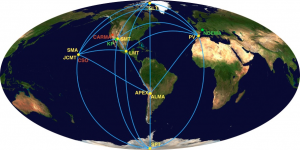 Accomplishements in microfluidics and analytical chemistry are normally front and centre in this blog, but this is a nod to some great work in physics. It turns out physics is more complicated than F = ma. 😉
Accomplishements in microfluidics and analytical chemistry are normally front and centre in this blog, but this is a nod to some great work in physics. It turns out physics is more complicated than F = ma. 😉
There was a big splash in the media around April 10th about the first images of a black hole ever obtained, and they are indeed pretty fascinating. What is at least as fascinating is the coordinated, collaborative effort between the astrophysics teams in several countries to generate these images. A few editorial pieces summarise the tremendous scope of the work nicely on webpages at MIT, the Event Horizon Telescope (or EHT), and publisher IOP. There are six open-access publications listed at the bottom of the EHT page that describe the work and its results.
The teams all belong to the EHT which is an array of radiofrequency telescopes that work in harmony to image a given target at the same time. The resolution afforded by teaming the individual telescopes together is vastly better than that of any individual telescope. A few images from papers that were published simultaneously on April 10 show some of the results. The first shows several pictures of the M87 black hole taken from different observatories early in the project, before many of the efforts at noise reduction were implemented (image from Figure 4 of this paper).  The second shows the location of the different observatories in Europe, North and South America, Hawaii and Antarctica that were teamed together for the effort (image from Figure 1 of this paper).
The second shows the location of the different observatories in Europe, North and South America, Hawaii and Antarctica that were teamed together for the effort (image from Figure 1 of this paper).
To be able to work synchronously, all the observatories had to use precise timestamping of their images with atomic clocks. Each observatory generated so much data, about 1 PB (PB = petabyte = 1 million GB), that it was faster to simply fly the hard drives to the Max Planck Institute for Radio Astronomy (Germany) and MIT’s Haystack Observatory (Boston, US) for the data processing. Interestingly, the images  change appreciably from day to day, as shown below (image from figure 15 of this paper).
change appreciably from day to day, as shown below (image from figure 15 of this paper).
Any collaborative scientific effort of this size is remarkable, all the more so given the size of the groups in different countries, funding sources from yet many more countries, etc.
